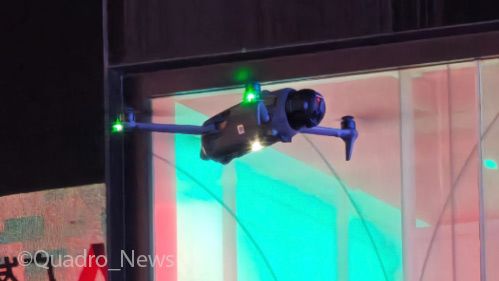DJI Mavic 4 rumors swirl, including price – 100MP "tennis ball drone" expected with some amazing features!
New DJI Mavic 4 leaked image fuels discussion of the ultimate drone's release date, price, and versions expected in early 2025

The Mavic 4 is expected sometime in 2025 and more and more leaks from the most reliable triumvirate have shown a design that appears to feature a "tennis ball" camera housing. Wait – there's nowhere to attach ND filters... but there's a very good reason for that...
You can sense the date is getting closer as some of the wild speculation seems to be dying away, while other – very interesting – specs seem to be settling. No longer, for example, is anyone talking about the sensor getting bigger than the 4/3 CMOS (anything larger would, as industry watcher Joseph Blake points out in his video, seriously threaten to cannibalize the Inspire 3).
It's now rumored that there will be a 100MP image sensor – that's A LOT more than before (the Mavic 3 Pro's main camera has a 20MP image sensor). Even 2x with binning – a crop from the middle as a 2x digital zoom) that'd be 25MP – still an improvement. This is what Apple call a hybrid sensor. (Of course I'm assuming that it's 100MP for the main sensor, and not a sum total for all the cameras as some phone manufacturers do!
A detail from the latest leak which will draw mixed reception is the prospect of a 28mm rather than 24mm main camera. Personally I prefer the slightly narrower field of view with less distortion, but others want the widest. This matter of taste also affects mapping projects.
On the flip side, you'll get an f/2 rather than an f/2.8 aperture adding more flexibility in lower light – again there is a rumoured 14-stop dynamic range from a dual-native ISO. Lots of 'pro camera' specs here, which all makes sense given that DJI have generally been improving low-light performance and safety, as we saw with the recent Air 3S.
👉You asked for a Mavic 4 Pro...#dji #djimavic4pro pic.twitter.com/3MMsmPTl4ZJanuary 1, 2025
There is also discussion about a variable, stepless built-in ND filter. That's very exciting in general, but especially in a drone where changing filters involves flying back to base and handling the drone. How this is done across cameras (if there ARE more than one) is as yet unclear.
Finally, the FCC approved a 99.5 watt-hour battery – that suggests a flight time of comfortably over 50 minutes (and perhaps a big powerful new charger!) There is also talk of up to 40KM (25-mile) range – Occusync 4+ and a new controller.
Get the Digital Camera World Newsletter
The best camera deals, reviews, product advice, and unmissable photography news, direct to your inbox!
I can not confirm or deny it yet @hakasushi ... but if the date is correct. We will probably see the specs leak around March 15. Unless some insider will share it sooner. Thanks for making this collection! Cheers https://t.co/b9EUonY1BF pic.twitter.com/5gPC4E9EOODecember 6, 2024
All of this amounts to a massive upgrade to the Mavic 4's capabilities, so what might it cost? Joseph Blake reckons there will be a base model (single camera, like the 'Classic') for $2,200 (about £1,800 / AU$3,600) rising to a $2,800 for the Mavic 4 Pro and the Cine version somewhere between $4,000 and $5,000. Not, in other words, a huge jump up in price.
Relase-wise? Don't expect it straight away he says – March announcement, April release seems to be a bet. His suggestion? Similar to mine, actually one of my picks for the best camera drone – the Air 3S – might tide you over!

With over 20 years of expertise as a tech journalist, Adam brings a wealth of knowledge across a vast number of product categories, including timelapse cameras, home security cameras, NVR cameras, photography books, webcams, 3D printers and 3D scanners, borescopes, radar detectors… and, above all, drones.
Adam is our resident expert on all aspects of camera drones and drone photography, from buying guides on the best choices for aerial photographers of all ability levels to the latest rules and regulations on piloting drones.
He is the author of a number of books including The Complete Guide to Drones, The Smart Smart Home Handbook, 101 Tips for DSLR Video and The Drone Pilot's Handbook.
